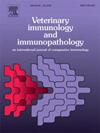绵羊外周血单核细胞反刍大肠杆菌pLAMP多表位DNA聚乳酸-羟基乙酸纳米颗粒疫苗的体外鉴定
IF 1.4
3区 农林科学
Q4 IMMUNOLOGY
引用次数: 0
摘要
心水病是一种由反刍埃利希菌引起的蜱传疾病,对小农有重大的经济影响。本研究探讨了聚乳酸-羟基乙酸(PLGA)纳米颗粒(NPs)作为抗心水pLAMP多表位DNA疫苗递送系统的潜力。该疫苗旨在增强抗原呈递和特异性免疫应答的激活,包括CD4 + 和CD8 + T细胞激活。制备的微球表面光滑,直径为180 nm ~ 5 µm,吸附效率为83 %。体外释放动力学表明,从PLGA NPs中吸附的pLAMP DNA的初始释放在第7天达到峰值,在第35天再次达到峰值。利用吸附在PLGA NPs上的Vitality hrGFP II质粒确认细胞摄取和基因表达。利用高通量转录组测序技术测定了疫苗在体外免疫绵羊外周血单个核细胞(PBMCs)中激活的免疫应答。pLAMP质粒转录本被证明存在,关键的免疫途径,包括DNA传感途径、MHC呈递和CD4 + T细胞和CD8 + T细胞途径被激活,这些途径与之前鉴定和用于疫苗设计的途径相对应。这表明pLAMP-NP疫苗有能力诱导所需的免疫反应,显示了体内研究的潜力。本文章由计算机程序翻译,如有差异,请以英文原文为准。
In vitro characterization of the E. ruminantium pLAMP multi-epitope DNA poly (lactic-co-glycolic acid) nanoparticle vaccine in sheep peripheral blood mononuclear cells
Heartwater is a tick-borne disease caused by Ehrlichia ruminantium, that has a major economic impact on smallholder farmers. This study investigates the potential of Poly Lactic-co-Glycolic Acid (PLGA) nanoparticles (NPs) as a delivery system for the pLAMP multi-epitope DNA vaccine against heartwater. The vaccine was designed to enhance antigen presentation and activation of specific immune responses, including CD4 + and CD8 + T cell activation. Spherical microspheres with smooth surfaces ranging from 180 nm to 5 µm in diameter were produced, with an adsorption efficiency of 83 %. The in vitro release kinetics demonstrated an initial release of adsorbed pLAMP DNA from PLGA NPs peaking at day 7 and again at day 35. Cellular uptake and gene expression were confirmed using the Vitality hrGFP II plasmid that was adsorbed onto PLGA NPs. High throughput transcriptome sequencing was utilized to determine the immune response activated by the vaccine in vitro in immune sheep peripheral blood mononuclear cells (PBMCs). The pLAMP plasmid transcripts were shown to be present, and key immune pathways, including DNA sensing pathways, MHC presentation and CD4 + T cell and CD8 + T cell pathways were activated that corresponded to those identified and used for the vaccine design previously. This is an indication of the capability of the pLAMP-NP vaccine to induce the desired immune responses, demonstrating potential for in vivo studies.
求助全文
通过发布文献求助,成功后即可免费获取论文全文。
去求助
来源期刊
CiteScore
3.40
自引率
5.60%
发文量
79
审稿时长
70 days
期刊介绍:
The journal reports basic, comparative and clinical immunology as they pertain to the animal species designated here: livestock, poultry, and fish species that are major food animals and companion animals such as cats, dogs, horses and camels, and wildlife species that act as reservoirs for food, companion or human infectious diseases, or as models for human disease.
Rodent models of infectious diseases that are of importance in the animal species indicated above,when the disease requires a level of containment that is not readily available for larger animal experimentation (ABSL3), will be considered. Papers on rabbits, lizards, guinea pigs, badgers, armadillos, elephants, antelope, and buffalo will be reviewed if the research advances our fundamental understanding of immunology, or if they act as a reservoir of infectious disease for the primary animal species designated above, or for humans. Manuscripts employing other species will be reviewed if justified as fitting into the categories above.
The following topics are appropriate: biology of cells and mechanisms of the immune system, immunochemistry, immunodeficiencies, immunodiagnosis, immunogenetics, immunopathology, immunology of infectious disease and tumors, immunoprophylaxis including vaccine development and delivery, immunological aspects of pregnancy including passive immunity, autoimmuity, neuroimmunology, and transplanatation immunology. Manuscripts that describe new genes and development of tools such as monoclonal antibodies are also of interest when part of a larger biological study. Studies employing extracts or constituents (plant extracts, feed additives or microbiome) must be sufficiently defined to be reproduced in other laboratories and also provide evidence for possible mechanisms and not simply show an effect on the immune system.

 求助内容:
求助内容: 应助结果提醒方式:
应助结果提醒方式:


